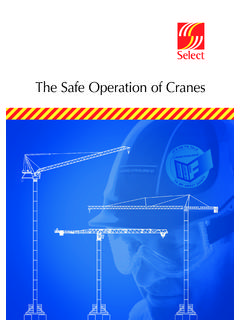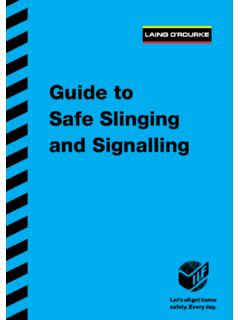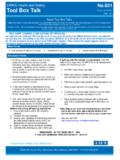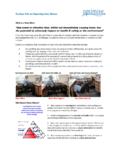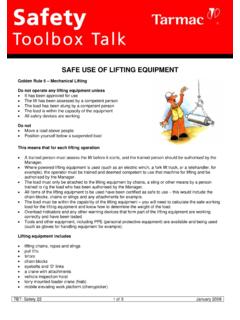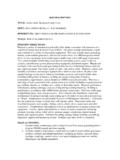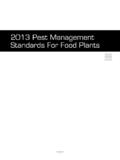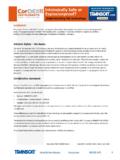Transcription of Safe Isolation of Plant and Equipment - Health & …
1 ESSENTIAL. STANDARD. safe Isolation of Plant and Equipment KEY MESSAGES. Identify the hazards and assess the risks. Ensure people involved are trained and competent. Have a clear Isolation procedure or safe system of work to follow. Test and monitor the effectiveness of the Isolation to ensure it remains secure. Ensure good communication and plans are in place for safe reinstatement of assets/ processes when works are complete. ON. 1. Introduction OFF. Work is done on Thames Water assets every day that requires them to be safely isolated first. These works can require simple electrical or mechanical self- Isolation procedures, or more complex isolations for chemical lines, tunnel inspections, pumped-mains repairs, etc.
2 The aim of this procedure is to set out guiding principles and standards that must be used to safely isolate all assets. This includes risk assessments, proper Isolation controls, and testing how well controls work. 2. Definitions Isolation the removal or blocking Lockout the placement of a OFF ON. of all energy sources from an item lockout device with a unique key, of Plant or Equipment , to prevent applied to an Isolation point to ensure danger from mechanical , electrical, that the Plant or Equipment being hydraulic or stored energy hazards. controlled cannot be operated until the lockout is removed.
3 3. Competence Any person involved in the Isolation of Plant and Equipment must have the appropriate knowledge, training and competencies to ensure the Isolation is carried out correctly, TRAINED. AND effectively and safely, as well as in line with Thames Water procedures. This includes, but COMPETENT. is not limited to, responsibilities such as: Planning isolations Authorising isolations (issue of TWOSA and secondary permits). Receiving and implementing secondary permits Authorising scope of work variations Installing and removing isolations The Thames Water Permits and Authorisations Course' provides foundation knowledge for those managing the safe Isolation of Plant and Equipment .
4 The person who is responsible for issuing a permit must be formally appointed in writing for the specific location (via the LOAD document). The person receiving the permit must be formally appointed by the activity owner. September 2017 Page 2. 4. Procedure Isolation of Plant and Equipment varies in complexity, from simple self- Isolation procedures to more complicated isolations that are subject to a formal documented procedure and a PROCEDURE. permit to work. STEP 1. STEP 2 The categories of isolations performed regularly within Thames Water are shown in STEP 3 Table 1. The same basic principles are applied in the majority of isolations.
5 Category Activities / isolations carried out A Routine works of short duration and reactive fault finding on maintainable assets by competent person including short duration mains repairs. Self- Isolation (electrical or mechanical ). B Isolation of maintainable assets for longer periods ( while waiting for parts). Self- Isolation with key controlled by COP (maintenance Isolation ). May require completion of an Isolation certificate if a third party will be working on the Equipment . C Non-routine works, those involving multiple Isolation points and/or more than one person involved in the works. May require SHE4 or PTW.
6 D Intrusive works, or inspections involving persons entering or working directly on assets for a prolonged period from multiple parties. Multiple Isolation points require full documented procedure, permits and authorisations. Table 1. Categories of Isolation When working on assets, define a safe system of work that properly identifies the hazards and safe how they are controlled. The best method of control is to eliminate the hazard. To do this, isolate SYSTEM. the process from energised sources that have the potential to cause harm. When isolating an OF WORK. asset or process, use an effective and secure method.
7 To achieve and maintain a safe Isolation , see the process detailed in Figure 1. A diagram showing how this process works is contained in Appendix I. 1. Hazard Identification 2. Risk Assessment and Selection of Isolation Methods 3. Planning and Preparation of Equipment 4. Installation of Isolation 5. Draining, Venting, Purging, Flushing (Where Applicable). 6. Testing and Monitoring Effectiveness of Isolation at Defined Frequencies 7. Completing Works 8. Reinstatement Fig 1. safe Isolation procedure September 2017 Page 3. 1. Hazard Identification When identifying the hazards involved in the works, consider all types of energy that have the potential to cause harm.
8 This can include electrical, mechanical , fluids, media, gases, and stored energy sources. It is important to consider if there are moving parts that could be a hazard, even after Equipment has been electrically isolated, for example fan blades or motor shafts. It is important to recognise that hazards may also be created by the Isolation itself. For example, if an electrical panel feeds more than one item of Equipment , switching it off could affect other processes or safety controls. 2. Risk Assessment and Selection of Isolation Methods RISK. RISK. ASSESSMENT. ASSESSMENT. Carry out a risk assessment to determine any possible Isolation failures, and also detail the likelihood and consequences of these failures.
9 Keep the following risk factors in mind: Severity / consequence Y/N Likelihood of failure Y/N. Could personnel be at risk of injury or Is the Isolation point located in a secure area other adverse event if the Isolation failed? on site with restricted access from personnel? Could the process be compromised if the Is the Isolation point located in an area Isolation failed? that is accessible to the public? Could the potable water supply be Is the Isolation point located in an area affected if the Isolation failed? where there is a history of vandalism or security breach? Could members of the public be injured or Is it possible to apply a secure lockable adversely affected if the Isolation failed?
10 Isolation on the asset? Could the environment be impacted Does the Isolation point operate fully and if the Isolation failed? ( gas or correctly? ( no let-by.). chemical leak, flooding.). Testing and monitoring Y/N. Has the frequency of testing and monitoring the Isolation been determined? The risk assessment helps in choosing the method of Isolation and the Equipment used for the process. Also consider the risks to persons during the installation of the Isolation . September 2017 Page 4. 3. Planning and Preparation of Equipment PLAN. safe and effective isolations of assets and processes require good and careful planning.
